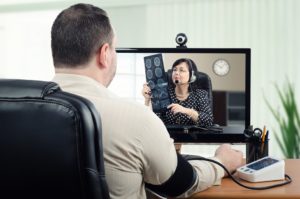The top five trends revolutionizing the future of digital health
The digital health industry is transforming the way we approach health and wellness. From augmented reality and 3D technology helping doctors study anatomy without cutting open a cadaver, to new technologies developed to treat extremely rare and aggressive cancers, healthcare as we know it is changing.
As billions in investment pour into digital health companies – in the first three months of 2018 alone there was a reported $1.2 billion invested – new trends and technological developments are helping us to reimagine healthcare from disease treatment to healthy diets to behaviour change and more. So what big breakthroughs are changing healthcare today?
AI and machine learning will help us better understand and treat diseases
Technology to collect and track data has been moving at light speed the past few years, and as a result, there are petabytes of health data ripe for analysis – but it would take years to manually comb through it, so the challenge now is to develop the right tools and architecture to analyse and use that data effectively. We expect to see some great innovation in AI and machine learning to process data, and it could trigger transformations in the way we see the world- particularly in our approach to diseases. With the right tools and the right data, we could start to find answers for questions such as why are some overweight people more likely than others to develop type 2 diabetes or heart disease? Or why do some people in families prone to disease manage to go without developing them?

A demonstration of what telehealth conferencing could look like in the future, with a doctor checking over a man’s brain scan and blood pressure remotely.
Digital tools to break bad habits will increase
Our desire to track and monitor our health using digital tools continues to grow, and the number of connected wearable devices worldwide is expected to increase to over 830 million in 2020, with digital health applications being the leading category. Who would’ve thought that wearing an Apple Watch could save your life? Just last year, a consumer received a notification for an abnormal heart rate which turned out to be a pulmonary embolism. These tools are designed to help you make the right health decisions. Traditionally designed to address weight loss, fitness or sleep, we will see more apps come online to help with things like choosing the right food to eat, tools which may alert you when you pick up the wrong food at the shops, and even applications to help you recover from surgery or improve rehabilitation. A key trend will be a shift from monitoring behaviour to shaping or breaking bad behaviour.
We’ll get more nutrients from our food- without trying
While the basics of healthy eating are well known, getting people to change their behaviour to live healthier lives has proven tricky. We expect a growing focus on adjusting commonly eaten ingredients to contain more vitamins or nutrients to help people be healthier without major behavioural change. For example, while oats have great cholesterol-lowering properties, they’re not as popular as wheat. So it would be beneficial to look at those properties, isolate those benefits and find a way to add that into wheat.

The future of in-home care for the elderly could be Smarter Safer Homes
More tech will help elderly or ill people stay living at home
Maintaining your independence can become difficult as you get older, but with aging populations in many countries, it’s critical that people are supported to stay independent as long as they can. Our researchers expect to see an increase in technological advances to support people to stay in their own homes. This could include telehealth to support people to leave hospital with continued monitoring, or using a combination of wearables, non-wearable sensors (such as motion or heartrate sensors) and automation to help the elderly safely live in their own homes for longer. A recent example of technological advances helping the elderly is VarientSpark, a cloud-based, machine learning method used to uncover the molecular origins of dementia and ALS.
Real-time service modelling will make more efficient hospitals
How many people do you think break their arm in a day? Currently, hospitals rely on estimates to plan staffing and resources. We anticipate seeing a new, real-time service modeling that can give hospitals new insights and a better ability to predict seemingly random events. For instance, modelling could predict the number of people with broken arms at a certain time or day – so the hospital can better plan staff and resourcing accordingly to improve patient outcomes and help switch their focus from reactive to proactive. At CSIRO, we’re seeing this technology emerging into the U.S. health systems markets, and are actively looking to license our own technology in the states.
